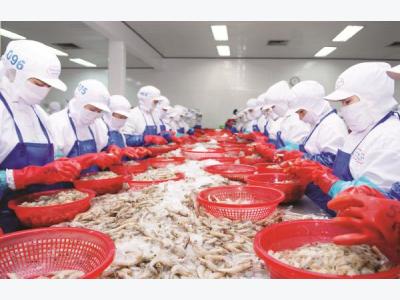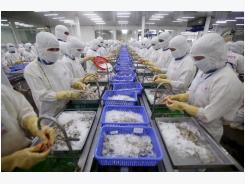Viet Nam seafood exports: Endless obstacles

In January 2017, Spanish commercial television channel Cuatro broadcast inaccurate and subjective information (polluted, dirty, heavy metals, environmental pollution) on Vietnam’s tra fish bred in the Cửu Long (Mekong) River,causing immeasurable and long-term negative impacts on the image of Vietnam seafood in certain markets, said VASEP General Secretary Truong Dinh Hoe.
Processing aquaculture for exports. Photo: Thu Hoa
Barriers from export markets
According to Truong Dinh Hoe, after the smear information was broadcast, from February 2017 to early May, a number of EU retail chains announced to stop selling Vietnam fish products in all stores for fear of negative impacts on the environment from the fish farm.
This is not the first time Vietnam seafood products were smeared by foreign media. Instead, using media to smear Vietnamese tra fish- the most powerful competitors with native white fish has become smear campaigns in various European countries since 2010. Now, under the spread of internet and social networks, such negative information has caused persistent impacts and been identified to affect the consumption of Vietnam seafood in 2017.
Not only challenged by defamatory information from overseas media, Vietnam seafood exports also face problems of anti-dumping duty, CVD or regulations on chemical test or separate inspection programs such as: strengthened America catfish Inspectorate. Seafood products, especially shrimp will be under competitive pressures from other exporting markets in Asia and South America. Since the ban of Australia on importing of shrimp and undercooked shrimp for 6 months from 9 January 2017 due to white spot virus detection in retail stores, Vietnamese shrimp enterprises have been hurt severely. Although there have been some adjustments from Australia, the situation has not improved much, especially, many contracts have been cancelled. In addition to these factors, droughts, saltwater intrusion and brood shrimp shortages also hinder the exporting volume of Vietnam in the first months of 2017.
In terms of tax, although China reduced import taxes on 17 aqua products from 1- January 2017 (7 items had reduced tax rates previously), however, according to the Chinese Ministry of Commerce, this is only "temporary" to improve the supply shortage because they can apply normal duties at any time.
Positive movements
After receiving information about the Cuatro report, VASEP sent a letter to the local media, rejecting it in its entirety, stressing that Viet Nam’s tra fish production was hygienic and safe to consume. According to VASEP, the tra fish industry in Viet Nam has improved its production process and quality management.. At the same time, VASEP also proposed the Ministry of Agriculture and Rural Development to have timely direction to limit the negative effects of footage to the fish consumption in Europe in particular and the world in general, as well as to limit the recurrence of similar incidents in the future.
According to VASEP, the international Certification body of aquaculture quality and environment expressed disapproval when European retailers decided to stop selling Vietnam fish. Council of Aquaculture Management (ASC) also delivered a press release to protest the decisions of European retailers. According to this agency, Vietnam tra fish farming is controlled and supervised strictly and totally in accordance with ASC standard in order to ensure the minimum negative impact on the environment. Therefore, consumers can totally believe in Vietnam’s tra fish products.
As for the ban on imports of shrimp and undercooked shrimp meat of Australia, the Minister of Industry and Trade sent a formal letter and to the Australia Minister of Trade and Minister of Agriculture - Natural Resources to ask for consideration of lifting this ban in the nearest time because it has caused negative impacts on farming, manufacturing, processing and shrimp export of Vietnam.
In spite of difficulties, seafood export values are estimated to continue to grow. According to the VASEP, seafood exports in 2017 will reach about $US 7.4 billion, up 6% compared to 2016.According to experts, in 2017, Vietnam's fisheries will continue to be subject to technical barriers and trade protection from import markets. However, thanks to the promotion of advantages and value of processed products, the industry will not only grow but also contribute to the overall growth of the agricultural sector. So far, Vietnam's seafood products have been exported to 161 markets. Thanks to the signing of trade agreements, Vietnam's seafood benefits from tariffs but will be subject to the application of non-tariff barriers which are aimed at protecting the domestic industry.
Related news
Tools

Phối trộn thức ăn chăn nuôi

Pha dung dịch thủy canh

Định mức cho tôm ăn

Phối trộn phân bón NPK

Xác định tỷ lệ tôm sống

Chuyển đổi đơn vị phân bón

Xác định công suất sục khí

Chuyển đổi đơn vị tôm

Tính diện tích nhà kính

Tính thể tích ao




 Canada trade mission highlights need for food safety…
Canada trade mission highlights need for food safety…  Fishermen seeking work abroad scammed
Fishermen seeking work abroad scammed